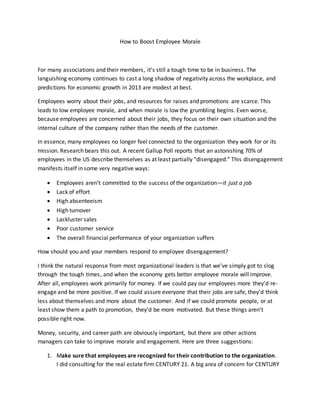
association article - Copy
- 1. How to Boost Employee Morale For many associations and their members, it’s still a tough time to be in business. The languishing economy continues to cast a long shadow of negativity across the workplace, and predictions for economic growth in 2013 are modest at best. Employees worry about their jobs, and resources for raises and promotions are scarce. This leads to low employee morale, and when morale is low the grumbling begins. Even worse, because employees are concerned about their jobs, they focus on their own situation and the internal culture of the company rather than the needs of the customer. In essence, many employees no longer feel connected to the organization they work for or its mission. Research bears this out. A recent Gallup Poll reports that an astonishing 70% of employees in the US describe themselves as at least partially “disengaged.” This disengagement manifests itself in some very negative ways: Employees aren’t committed to the success of the organization—it just a job Lack of effort High absenteeism High turnover Lackluster sales Poor customer service The overall financial performance of your organization suffers How should you and your members respond to employee disengagement? I think the natural response from most organizational leaders is that we’ve simply got to slog through the tough times, and when the economy gets better employee morale will improve. After all, employees work primarily for money. If we could pay our employees more they’d re- engage and be more positive. If we could assure everyone that their jobs are safe, they’d think less about themselves and more about the customer. And if we could promote people, or at least show them a path to promotion, they’d be more motivated. But these things aren’t possible right now. Money, security, and career path are obviously important, but there are other actions managers can take to improve morale and engagement. Here are three suggestions: 1. Make sure that employees are recognized for their contribution to the organization. I did consulting for the real estate firm CENTURY 21. A big area of concern for CENTURY
- 2. 21 was the retention of its top producing agents. Our research showed that when agents left CENTURY 21, they initially cited increased compensation as the reason for the move. However, when we drilled down, we almost always found other factors, and what frustrated the agents more than anything else is that they did not feel appreciated for their contribution to the company. You cannot overstate it: Appreciation and recognition are huge motivators. You can do it formally or informally, but find ways to show your quality employees how much you appreciate their accomplishments. 2. Employees want to develop their skills. In a slow economy, training may be one of the first budget cuts. This is unfortunate because quality training not only delivers a competitive advantage—it shows employees that you are committed to their long term success. Don’t just focus on job related skills; employees also want personal development training in areas such as time management, communication, finance, and health. 3. Employees appreciate being part of a team. This happens when there is ongoing communication within an organization, and everyone understands the association’s core mission, overall strategy, and priorities. Also, communication is not just from top to bottom. Large associations and member organizations should develop systems for collecting information from the bottom up so that success stories, innovations, and (sometimes) problems can be communicated across departments. I realize that these three suggestions may be regarded as common sense. However, because of reductions in the workforce, many associations are trying to do more with less. Managers are so busy reacting to problems that common sense is not always common practice. Do you know how engaged your employees are? Perhaps not. You sense that something is wrong, but you’re not sure precisely what the problems are. Getting feedback from employees is an important part of developing a high performance organization. You can take an informal approach to getting feedback, but the most accurate methodology is through a well-structured Employee Engagement Survey delivered by a third party. By using a third party, you guarantee the objectivity of the survey as well as the anonymity of the respondents. You need the unvarnished truth to make wise decisions. Robert Wicker is the President of Red Oak Training & Development, based in Tallahassee, Florida. He has over 25 years of training and consulting experience, specializing in leadership
- 3. skills and organizational performance. For more information call 850-294-6503 or go to redoaktraining.com.
